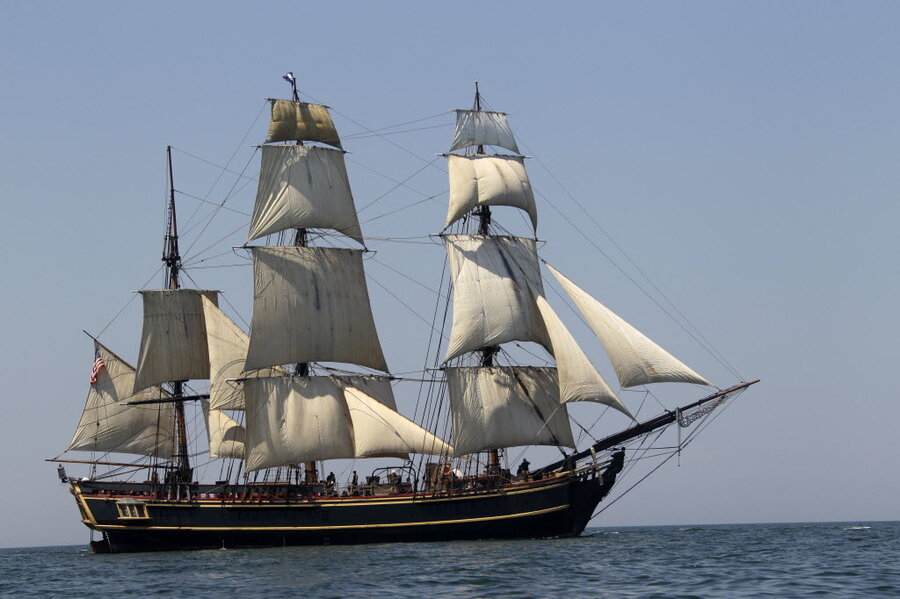The Bounty finding: Captain's bid to sail into superstorm was 'reckless'
Loading...
On Oct. 29, 2012, as superstorm Sandy spun hard and fast over the Atlantic Ocean, the crew members of a ship that looked curiously like one from 300 years ago – and that was, even more curiously, heading straight toward a hurricane – lobbied their captain to make for shore. He told them no, and he plowed the ship onward. That decision was a fatal one.
This is the finding of the National Transportation Safety Board’s inquiry into the sinking of The Bounty, a replica of an 18th-century British sailing ship, which killed the captain and one of his deckhands, as well as wounded three other crew members. In a 16-page report, the board pinned blame for the loss of life and ship on The Bounty’s captain, Robin Walbridge, who the report said made a "reckless" decision to plunge the ship into the path of a monster hurricane, a move that “compromised the safety of everyone on board."
“The National Transportation Safety Board determines that the probable cause of the sinking of tall ship Bounty was the captain’s reckless decision to sail the vessel into the well-forecasted path of Hurricane Sandy,” the report said, “which subjected the aging vessel and the inexperienced crew to conditions from which the vessel could not recover.”
The report, based in part on the testimony of surviving crew members at a US Coast Guard hearing last February in Portsmouth, Va., also attributed some fault to the boat’s owner, Robert Hansen, and his company, The HMS Bounty Organization. It found that Mr. Hansen had not intervened in the captain’s plans to take the ship out, despite well-publicized warnings of extreme weather, and had maintained inadequate oversight of the ship’s upkeep.
The Bounty, a three-masted, 108-foot ship, was built for MGM Studio’s “Mutiny on the Bounty” in 1962, and had since been moored as a tourist attraction at ports along the East Coast. It did not do much traveling, except for brief trips to appear as a prop in celebrations.
And it was moored for good reason: Its wooden hull was rotting, and the blight had been badly sealed with a household sealer. Its pumps, not properly inspected, were not in prime working condition, the National Transportation Safety Board (NTSB) said.
On Oct. 25, 2012, alarm bells were ringing up and down the East Coast that a major hurricane was due to whirl along the coastline. That evening, Captain Walbridge called The Bounty’s crew to a meeting and announced plans to sail the ship from its then-port at New London, Conn., to St. Petersburg, Fla., for a Nov. 10 appearance at an event there.
He told his crew that anyone could opt out of the trip but also said that an opt-outer would have to pay his or her own way to meet the ship in Florida and would be leaving his or her colleagues in a lurch, with a bigger workload. He also said the trip was safe, the report said. Crew members later testified that Walbridge believed that a ship was safer at sea in a storm than in port, according to The Associated Press.
No one opted out; the ship sailed at 5 p.m., the report said. All went well for a day and a half. But on Oct. 27, for reasons to which crew members said they were not privy, Walbridge turned the ship southwest, despite forecasts that the storm was to the west. The NTSB said the captain might have misjudged the width of the storm – more than 1,000 miles in diameter – or might have believed that the aging, ailing ship “could outrace the storm.”
By the time the captain sent out a belated distress call to the Coast Guard at about 9 p.m. on Oct. 28, the ship’s high masts had been ripped up and the engine room was flooded in water four feet deep; winds had also reached highs of 90 knots, and seas were between 25 and 30 feet, the report said. At about 4 a.m., some 110 nautical miles southeast of Cape Hatteras, N.C., the ship tipped on its side, spilling its crew into the water.
Walbridge went down with the ship, and his body was never found. Claudene Christian, a deckman, was also killed, and her body was found 10 hours after the ship sank. Coast Guard helicopters picked up the 14 surviving crew members.
Hansen’s HMS Bounty Organization faces a $70 million negligence lawsuit from the mother of Ms. Christian, according to AP. The Bounty’s former engineer, Christopher Barksdale, who sustained injuries in the disaster, is also suing Mr. Hansen and HMS for an unspecified amount, the AP reports.








